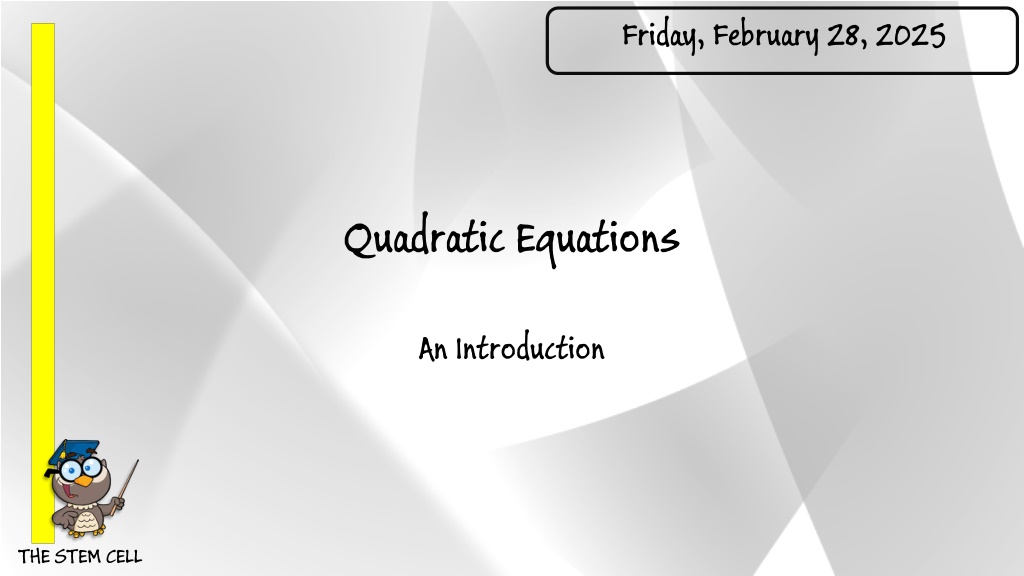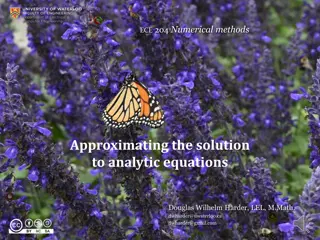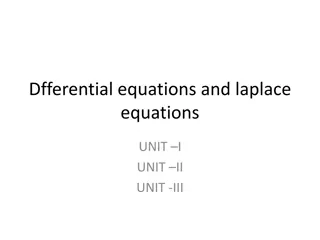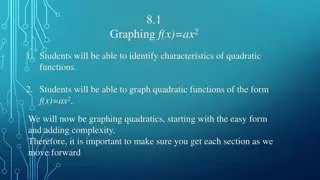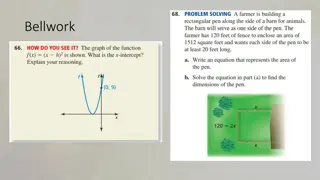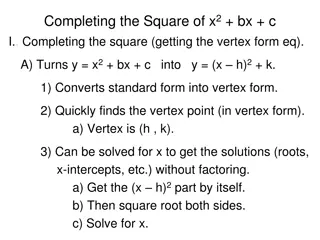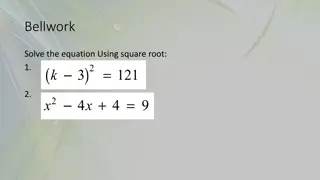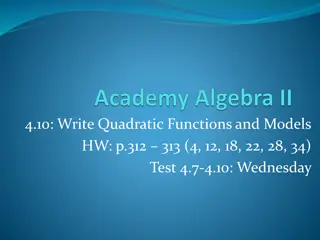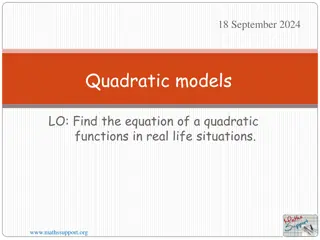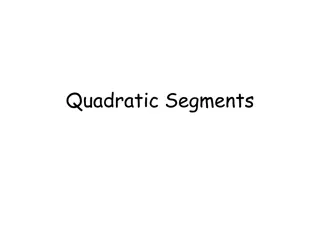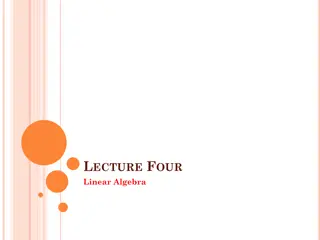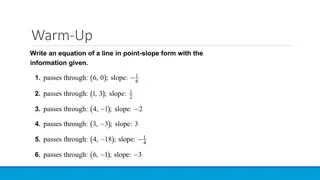Quadratic Equations
Quadratic equations involve variables raised to the power of 2, requiring a different approach from linear equations. This introduction explains the nature of quadratic equations and how to solve them through factorization. Through examples and step-by-step instructions, readers can learn how to identify the solutions of quadratic equations for both real and complex numbers.
Download Presentation

Please find below an Image/Link to download the presentation.
The content on the website is provided AS IS for your information and personal use only. It may not be sold, licensed, or shared on other websites without obtaining consent from the author.If you encounter any issues during the download, it is possible that the publisher has removed the file from their server.
You are allowed to download the files provided on this website for personal or commercial use, subject to the condition that they are used lawfully. All files are the property of their respective owners.
The content on the website is provided AS IS for your information and personal use only. It may not be sold, licensed, or shared on other websites without obtaining consent from the author.
E N D
Presentation Transcript
Friday, February 28, 2025 Quadratic Equations An Introduction THE STEM CELL
Before we start This slide carries a very important message (c) Glasbergen.com (Reproduced with permission) THE STEM CELL
Friday, February 28, 2025 Quadratic Equations An Introduction THE STEM CELL
Friday, February 28, 2025 We have already seen linear equations (equations with single-power values for the variable 'x') and how these will produce graphs which are a straight line, the general formula is: Now we will take a look at the next order of algebraic expressions and equations, those which hold an instance of the variable x to a second power: Where a , b and c are numbers with integer values. These equations have usually two solutions, that is, two numbers whose values satisfy the equation. These numbers can be the same value, or different. There is another type of solution involving complex numbers but we will not look at these here. THE STEM CELL
Friday, February 28, 2025 So, how do we solve such equations? There are several ways, but first of all we will look at solution by factorisation where we will split the expression into two bracketed expressions for x and obtain values for x such that one of the two pairs of brackets becomes equal to ZERO. This will provide one of the solutions as the expression in whole becomes equal to zero. We need to obtain two numbers whose SUM comes to the value of the constant b shown in green, but whose product is the same as the product ac Let s look at an example: THE STEM CELL
Friday, February 28, 2025 Let s look at an example: Using the general equation we can see that we are looking for two numbers whose SUM is +1 but whose product is -12 pause for a moment to make sure you can see why this is the case. Step 1 write out the factors of 12, don t worry about signs at this stage. 1 2 3 4 6 12 Step 2 inserting + and can you locate two numbers whose SUM would be +1 AND whose PRODUCT would be -12 ? -3 and +4 Step 3 we can now split the linear expression (the one involving b ) into two: THE STEM CELL
Friday, February 28, 2025 Step 4 pair off the expressions and factorise: Step 5 Tidy up: To actually find the values of x that will satisfy the original equation we now look for individual values that will render each bracket equal to 0: THE STEM CELL
Friday, February 28, 2025 The values that satisfy the equation are called the roots of the Quadratic. In this case, two real numbers (this isn t always the case) Now have a go at these examples THE STEM CELL
Friday, February 28, 2025 a=+1, b=+6 and c=+8 Selection to satisfy ac and b requirements are +2 and +4 Factors of 6 are 1,2,4 Pair off: Factorise: Rearrange: THE STEM CELL
Friday, February 28, 2025 a=+1, b=-4 and c=-21 Factors of 21 are 1,3,7 Selection to satisfy ac and b requirements are +3 and -7 Pair off: Factorise: Rearrange: THE STEM CELL
Friday, February 28, 2025 Factors of 24 are 1,2,3,4,6,8,12 a=+2, b=-5 and c=-12 Selection to satisfy ac and b requirements are +3 and -8 Pair off: Factorise: Rearrange: THE STEM CELL
